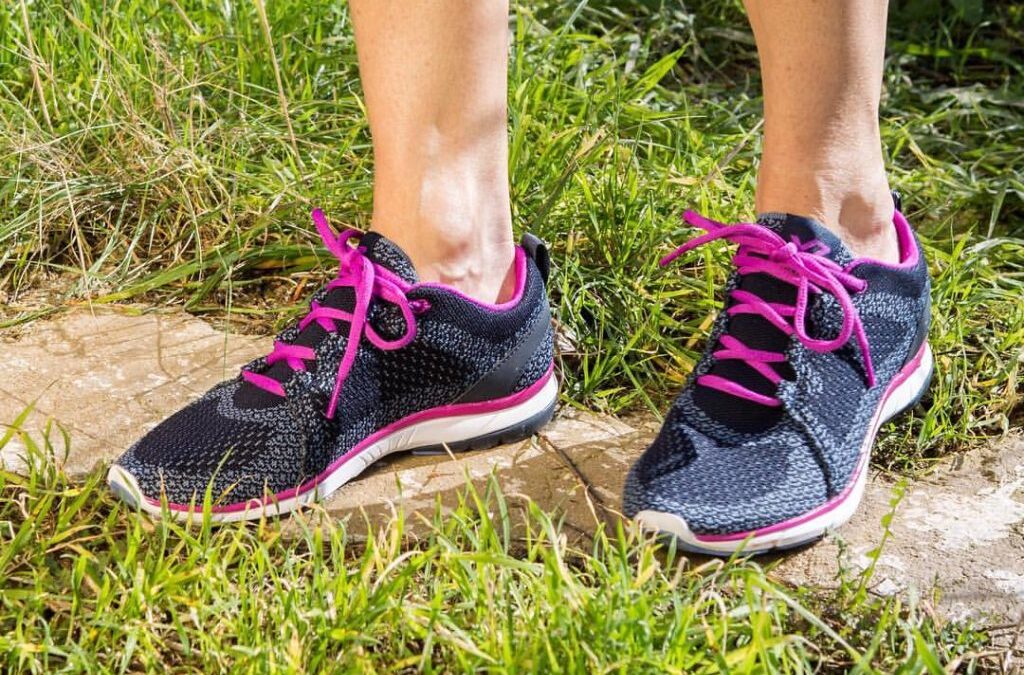Trainers are an important part of our wardrobe nowadays. They are great for our busy and active lives and good for our feet. However, with so many choices, what trainers should YOU be looking at?
I have realised in my clinic, many patients are choosing the wrong trainer for the activities they like to do, causing problems with their health. Manufacturers now offer such a wide range of activewear, it can be a daunting task whittling-down the best footwear for you.
So here are my tips for choosing a trainer as well as some of the pitfalls I have seen patients make in the past.
What is its function? What do you want the trainer for? Is it for walking the dog, running a half-marathon, mooching around town, playing sport on hard surfaces, walking on grass, etc.?
Choose the right trainer for the job
One trainer may not be suitable for all the activities you do, so be prepared to buy a few pairs. For example, manufacturers make specific trainers for different types of sport. A tennis trainer will be very different from a running trainer.
Go to a good sports shop if you play sport and ask for their advice rather than buying ‘off-the-shelf’ trainers and hoping for the best. They may also be able to check your running gait. Trainers with ‘Gel’ or ‘Air’ in the title are particularly good for high-impact sports. Patients often buy cheap ‘off-the-shelf’ trainers when they start a new fitness regime and they can be poorly made. This then leads to injury and long-term damage.
Width-fitting
Sometimes patients bring trainers into clinic that are too narrow for their feet. If you have a wide foot, you will need a wide-fit trainer. Do not force your feet into a narrower shoe for a ‘snug fit.’ This can cause issues such as corns, Morton’s Neuroma, nail damage, etc. Some makes are naturally wider than others, so find a manufacturer that suits your foot shape.
Size
Generally, it is advised to go up half a size bigger than you would in your everyday shoes. This is to accommodate a thicker sports sock and to give more room for the toes to move, reducing the risk of damage to nailbeds.
A good quality trainer will have an insole which is removable. Nowadays, some manufacturers glue-down a thin cover instead to cut-down costs. I have even removed the cover to find cardboard (!!) underneath. If the insole is removable, it will also accommodate an orthotic so look for trainers with a removable insole.
Low-profile trainers are currently popular but offer less support, particularly across the top of the foot and arch. Also, they cannot accommodate an orthotic. So, you may wish to rethink purchasing a pair for sport. They are fine for casual wear.
Casual trainers vs Sports Trainers
Often patients do not realise there is a difference. Sports manufacturers have embraced the fashion industry and it is a hugely important part of their turnover. So, one tip to know the difference is to look at the outer sole. If it mostly flat to the floor all the way along the trainer, then it is a casual trainer/lace-up (example below left). If the toe box angles upward to give a ‘rocker’ motion as you walk, it is more suitable for activewear. Another tip is to check you cannot bend it in half.
Slip-On Trainers vs Lace-Ups
Slip-on trainers are on-trend and they look great and are easy to just slip into. They are fine for lighter activities but I do not recommend them for high-impact activities. Look for ones that have velcro instead or come up high across the top of the foot. I’ve noticed recently, some slip-on trainers have a ‘sock-fit’ which is very comfortable and supportive (for example, Vionic Brisk Aimmy and Strive Metz). If you struggle to do laces up, but need a lace-up for sport, a good alternative are Bungee laces with toggles which will do the job (available from my online shop).
Breathable Fabrics
These are a fairly new innovation and very popular because trainers are lighter and one the advantages is it gives less muscle-fatigue. Leather/Neoprene trainers can also be quite ‘sweaty,’ especially in summer which may lead to fungal infections. Just be careful the upper of the trainer does not ‘collapse’ when you try to press it down and that you cannot bend it in half. If it does, there will not be enough support so only wear them for light activities/casual wear. However, many sports trainers CAN be supportive and breathable. For example, Asics and New Balance. Both these makes also accommodate an orthotic insole nicely. Obviously, they are not as water-resistant as leather/Neoprene.
So, there are many pitfalls with buying trainers and I hope my thoughts and tips will help you. Start by bearing in mind what you want it for when deciding – sport or leisure.
If you’d like any further advice, please get in contact, I am happy to help. Any good sports shop or your local sports coach/personal trainer should also be able to give you some recommendations.
Lorna Pullman (MCFHP MAFHP)



